CY7C68013A/CY7C68014A
CY7C68015A/CY7C68016A
EZ-USB FX2LP™ USB Microcontroller
— Programmable waveform descriptors and configu-
ration registers to define waveforms
— Supports multiple Ready (RDY) inputs and Control
(CTL) outputs
• Integrated, industry-standard enhanced 8051
— 48-MHz, 24-MHz, or 12-MHz CPU operation
— Four clocks per instruction cycle
— Two USARTS
— Three counter/timers
— Expanded interrupt system
— Two data pointers
• 3.3V operation with 5V tolerant inputs
• Vectored USB interrupts and GPIF/FIFO interrupts
• Separate data buffers for the Set-up and Data portions
of a CONTROL transfer
• Integrated I2C controller, runs at 100 or 400 kHz
• Four integrated FIFOs
— Integrated glue logic and FIFOs lower system cost
— Automatic conversion to and from 16-bit buses
— Master or slave operation
— Uses external clock or asynchronous strobes
— Easy interface to ASIC and DSP ICs
• Available in Commercial and Industrial temperature
grade (all packages except VFBGA)
Features (CY7C68013A/14A/15A/16A)
1.0
• USB 2.0–USB-IF high speed certified (TID # 40440111)
• Single-chip integrated USB 2.0 transceiver, smart SIE,
and enhanced 8051 microprocessor
• Fit, form and function compatible with the FX2
— Pin-compatible
— Object-code-compatible
— Functionally-compatible (FX2LP is a superset)
• Ultra Low power: ICC no more than 85 mA in any mode
— Ideal for bus and battery powered applications
• Software: 8051 code runs from:
— Internal RAM, which is downloaded via USB
— Internal RAM, which is loaded from EEPROM
— External memory device (128 pin package)
• 16 KBytes of on-chip Code/Data RAM
• Four programmable BULK/INTERRUPT/ISOCHRO-
NOUS endpoints
— Buffering options: double, triple, and quad
• Additional programmable (BULK/INTERRUPT) 64-byte
endpoint
• 8- or 16-bit external data interface
• Smart Media Standard ECC generation
• GPIF (General Programmable Interface)
— Allows direct connection to most parallel interface
24 MHz
Ext. XTAL
High-performance micro
using standard tools
with lower-power options
FX2LP
VCC
x20
PLL
/0.5
/1.0
/2.0
1.5k
connected for
full speed
D+
D–
USB
2.0
XCVR
Integrated
full- and high-speed
XCVR
CY
Smart
USB
1.1/2.0
Engine
)
6
1
(
s
s
e
r
d
d
A
)
8
(
t
a
a
D
8051 Core
12/24/48 MHz,
four clocks/cycle
)
8
(
s
u
B
a
a
D
t
I2C
Master
Additional I/Os (24)
/
)
6
1
(
s
s
e
r
d
d
A
ECC
GPIF
ADDR (9)
RDY (6)
CTL (6)
16 KB
RAM
Abundant I/O
including two USARTS
General
programmable I/F
to ASIC/DSP or bus
standards such as
ATAPI, EPP, etc.
4 kB
FIFO
8/16
Up to 96 MBytes/s
burst rate
Enhanced USB core
Simplifies 8051 code
“Soft Configuration”
Easy firmware changes
FIFO and endpoint memory
(master or slave operation)
Figure 1-1. Block Diagram
Cypress Semiconductor Corporation
Document #: 38-08032 Rev. *K
•
198 Champion Court
•
San Jose, CA 95134-1709
•
408-943-2600
Revised January 26, 2006
�
Features (CY7C68013A/14A only)
1.1
• CY7C68014A: Ideal for battery powered applications
— Suspend current: 100 µA (typ)
• CY7C68013A: Ideal for non-battery powered applica-
tions
— Suspend current: 300 µA (typ)
• Available in five lead-free packages with up to 40 GPIOs
— 128-pin TQFP (40 GPIOs), 100-pin TQFP (40 GPIOs),
56-pin QFN (24 GPIOs), 56-pin SSOP (24 GPIOs), and
56-pin VFBGA (24 GPIOs)
Features (CY7C68015A/16A only)
1.2
• CY7C68016A: Ideal for battery powered applications
— Suspend current: 100 µA (typ)
• CY7C68015A: Ideal for non-battery powered applica-
tions
— Suspend current: 300 µA (typ)
• Available in lead-free 56-pin QFN package (26 GPIOs)
— 2 more GPIOs than CY7C68013A/14A enabling addi-
tional features in same footprint
Cypress Semiconductor Corporation’s (Cypress’s) EZ-USB
FX2LP™ (CY7C68013A/14A) is a low-power version of the
EZ-USB FX2™ (CY7C68013), which is a highly integrated,
low-power USB 2.0 microcontroller. By integrating the USB 2.0
transceiver, serial interface engine (SIE), enhanced 8051
microcontroller, and a programmable peripheral interface in a
single chip, Cypress has created a very cost-effective solution
that provides superior time-to-market advantages with low
power to enable bus powered applications.
The ingenious architecture of FX2LP results in data transfer
rates of over 53 Mbytes per second, the maximum-allowable
USB 2.0 bandwidth, while still using a low-cost 8051 microcon-
troller in a package as small as a 56 VFBGA (5mm x 5mm).
Because it incorporates the USB 2.0 transceiver, the FX2LP is
more economical, providing a smaller footprint solution than
USB 2.0 SIE or external transceiver implementations. With
CY7C68013A/CY7C68014A
CY7C68015A/CY7C68016A
Interface
for application-specific
EZ-USB FX2LP, the Cypress Smart SIE handles most of the
USB 1.1 and 2.0 protocol in hardware, freeing the embedded
microcontroller
functions and
decreasing development time to ensure USB compatibility.
(GPIF) and
The General Programmable
Master/Slave Endpoint FIFO (8- or 16-bit data bus) provides
an easy and glueless interface to popular interfaces such as
ATA, UTOPIA, EPP, PCMCIA, and most DSP/processors.
The FX2LP draws considerably less current than the FX2
(CY7C68013), has double the on-chip code/data RAM and is
fit, form and function compatible with the 56-, 100-, and
128-pin FX2.
Five packages are defined for the family: 56VFBGA, 56 SSOP,
56 QFN, 100 TQFP, and 128 TQFP.
2.0
Applications
• Portable video recorder
• MPEG/TV conversion
• DSL modems
• ATA interface
• Memory card readers
• Legacy conversion devices
• Cameras
• Scanners
• Home PNA
• Wireless LAN
• MP3 players
• Networking
The “Reference Designs” section of the Cypress web site
provides additional tools for typical USB 2.0 applications. Each
reference design comes complete with firmware source and
object code, schematics, and documentation. Please visit
http://www.cypress.com for more information.
Document #: 38-08032 Rev. *K
Page 2 of 60
�
CY7C68013A/CY7C68014A
CY7C68015A/CY7C68016A
The CLKOUT pin, which can be three-stated and inverted
using internal control bits, outputs the 50% duty cycle 8051
clock, at the selected 8051 clock frequency—48, 24, or 12
MHz.
USARTS
3.2.2
FX2LP contains two standard 8051 USARTs, addressed via
Special Function Register (SFR) bits. The USART interface
pins are available on separate I/O pins, and are not multi-
plexed with port pins.
UART0 and UART1 can operate using an internal clock at
230 KBaud with no more than 1% baud rate error. 230-KBaud
operation is achieved by an internally derived clock source that
generates overflow pulses at the appropriate time. The
internal clock adjusts for the 8051 clock rate (48, 24, 12 MHz)
such that it always presents the correct frequency for
230-KBaud operation.[1]
Special Function Registers
3.2.3
Certain 8051 SFR addresses are populated to provide fast
access to critical FX2LP functions. These SFR additions are
shown in Table 3-1. Bold type indicates non-standard,
enhanced 8051 registers. The two SFR rows that end with “0”
and “8” contain bit-addressable registers. The four I/O ports
A–D use the SFR addresses used in the standard 8051 for
ports 0–3, which are not implemented in FX2LP. Because of
the faster and more efficient SFR addressing, the FX2LP I/O
ports are not addressable in external RAM space (using the
MOVX instruction).
I2C Bus
3.3
FX2LP supports the I2C bus as a master only at 100-/400-KHz.
SCL and SDA pins have open-drain outputs and hysteresis
inputs. These signals must be pulled up to 3.3V, even if no I2C
device is connected.
Buses
3.4
All packages: 8- or 16-bit “FIFO” bidirectional data bus, multi-
plexed on I/O ports B and D. 128-pin package: adds 16-bit
output-only 8051 address bus, 8-bit bidirectional data bus.
3.0
Functional Overview
USB Signaling Speed
3.1
FX2LP operates at two of the three rates defined in the USB
Specification Revision 2.0, dated April 27, 2000:
• Full speed, with a signaling bit rate of 12 Mbps
• High speed, with a signaling bit rate of 480 Mbps.
FX2LP does not support the low-speed signaling mode of
1.5 Mbps.
8051 Microprocessor
3.2
The 8051 microprocessor embedded in the FX2LP family has
256 bytes of register RAM, an expanded interrupt system,
three timer/counters, and two USARTs.
8051 Clock Frequency
3.2.1
FX2LP has an on-chip oscillator circuit that uses an external
24-MHz (±100-ppm) crystal with the following characteristics:
• Parallel resonant
• Fundamental mode
• 500-µW drive level
• 12-pF (5% tolerance) load capacitors.
An on-chip PLL multiplies the 24-MHz oscillator up to
480 MHz, as required by the transceiver/PHY, and internal
counters divide it down for use as the 8051 clock. The default
8051 clock frequency is 12 MHz. The clock frequency of the
8051 can be changed by the 8051 through the CPUCS
register, dynamically.
C1
24 MHz
C2
12 pf
12 pf
20 × PLL
12-pF capacitor values assumes a trace capacitance
of 3 pF per side on a four-layer FR4 PCA
Figure 3-1. Crystal Configuration
Note:
1.
115-KBaud operation is also possible by programming the 8051 SMOD0 or SMOD1 bits to a “1” for UART0 and/or UART1, respectively.
Document #: 38-08032 Rev. *K
Page 3 of 60
�
CY7C68013A/CY7C68014A
CY7C68015A/CY7C68016A
Table 3-1. Special Function Registers
8x
IOA
SP
DPL0
DPH0
DPL1
DPH1
DPS
PCON
TCON
TMOD
TL0
TL1
TH0
TH1
CKCON
x
0
1
2
3
4
5
6
7
8
9
A
B
C
D
E
F
9x
IOB
EXIF
MPAGE
Ax
IOC
INT2CLR
INT4CLR
IE
EP2468STAT
EP24FIFOFLGS
EP68FIFOFLGS
SCON0
SBUF0
AUTOPTRH1
AUTOPTRL1
reserved
AUTOPTRH2
AUTOPTRL2
Bx
IOD
IOE
OEA
OEB
OEC
OED
OEE
IP
Cx
SCON1
SBUF1
Dx
Ex
PSW ACC
Fx
B
T2CON
EICON
EIE
EIP
EP01STAT
GPIFTRIG
GPIFSGLDATH
GPIFSGLDATLX
RCAP2L
RCAP2H
TL2
TH2
reserved
AUTOPTRSET-UP GPIFSGLDATLNOX
USB Boot Methods
3.5
During the power-up sequence, internal logic checks the I2C
port for the connection of an EEPROM whose first byte is
either 0xC0 or 0xC2. If found, it uses the VID/PID/DID values
in the EEPROM in place of the internally stored values (0xC0),
or it boot-loads the EEPROM contents into internal RAM
(0xC2). If no EEPROM is detected, FX2LP enumerates using
internally stored descriptors. The default ID values for FX2LP
are VID/PID/DID (0x04B4, 0x8613, 0xAxxx where xxx = Chip
revision).[2]
Table 3-2. Default ID Values for FX2LP
Default VID/PID/DID
Vendor ID
Product ID
Device release
0x04B4 Cypress Semiconductor
0x8613 EZ-USB FX2LP
0xAnnn Depends on chip revision
(nnn = chip revision where first
silicon = 001)
ReNumeration™
3.6
Because the FX2LP’s configuration is soft, one chip can take
on the identities of multiple distinct USB devices.
When first plugged into USB, the FX2LP enumerates automat-
ically and downloads firmware and USB descriptor tables over
the USB cable. Next, the FX2LP enumerates again, this time
as a device defined by the downloaded information. This
patented two-step process, called ReNumeration™, happens
instantly when the device is plugged in, with no hint that the
initial download step has occurred.
Two control bits in the USBCS (USB Control and Status)
register control the ReNumeration process: DISCON and
RENUM. To simulate a USB disconnect, the firmware sets
DISCON to 1. To reconnect, the firmware clears DISCON to 0.
Before reconnecting, the firmware sets or clears the RENUM
bit to indicate whether the firmware or the Default USB Device
will handle device requests over endpoint zero: if RENUM = 0,
the Default USB Device will handle device requests; if RENUM
= 1, the firmware will.
Bus-powered Applications
3.7
The FX2LP fully supports bus-powered designs by enumer-
ating with less than 100 mA as required by the USB 2.0 speci-
fication.
3.8
Interrupt System
INT2 Interrupt Request and Enable Registers
3.8.1
FX2LP implements an autovector feature for INT2 and INT4.
There are 27 INT2 (USB) vectors, and 14 INT4 (FIFO/GPIF)
vectors. See EZ-USB Technical Reference Manual (TRM) for
more details.
USB-Interrupt Autovectors
3.8.2
The main USB interrupt is shared by 27 interrupt sources. To
save the code and processing time that normally would be
required to identify the individual USB interrupt source, the
FX2LP provides a second level of interrupt vectoring, called
Autovectoring. When a USB interrupt is asserted, the FX2LP
pushes the program counter onto its stack then jumps to
address 0x0043, where it expects to find a “jump” instruction
to the USB Interrupt service routine.
Note:
2. The I2C bus SCL and SDA pins must be pulled up, even if an EEPROM is not connected. Otherwise this detection method does not work properly.
Document #: 38-08032 Rev. *K
Page 4 of 60
�
CY7C68013A/CY7C68014A
CY7C68015A/CY7C68016A
The FX2LP jump instruction is encoded as follows.
Table 3-3. INT2 USB Interrupts
Priority
INT2VEC Value
Source
Notes
USB INTERRUPT TABLE FOR INT2
1
2
3
4
5
6
7
8
9
10
11
12
13
14
15
16
17
18
19
20
21
22
23
24
25
26
27
28
29
30
31
32
00
04
08
0C
10
14
18
1C
20
24
28
2C
30
34
38
3C
40
44
48
4C
50
54
58
5C
60
64
68
6C
70
74
78
7C
SUDAV
SOF
SUTOK
SUSPEND
USB RESET
HISPEED
EP0ACK
EP0-IN
EP0-OUT
EP1-IN
EP1-OUT
EP2
EP4
EP6
EP8
IBN
EP0PING
EP1PING
EP2PING
EP4PING
EP6PING
EP8PING
ERRLIMIT
EP2ISOERR
EP4ISOERR
EP6ISOERR
EP8ISOERR
Set-up Data Available
Start of Frame (or microframe)
Set-up Token Received
USB Suspend request
Bus reset
Entered high speed operation
FX2LP ACK’d the CONTROL Handshake
reserved
EP0-IN ready to be loaded with data
EP0-OUT has USB data
EP1-IN ready to be loaded with data
EP1-OUT has USB data
IN: buffer available. OUT: buffer has data
IN: buffer available. OUT: buffer has data
IN: buffer available. OUT: buffer has data
IN: buffer available. OUT: buffer has data
IN-Bulk-NAK (any IN endpoint)
reserved
EP0 OUT was Pinged and it NAK’d
EP1 OUT was Pinged and it NAK’d
EP2 OUT was Pinged and it NAK’d
EP4 OUT was Pinged and it NAK’d
EP6 OUT was Pinged and it NAK’d
EP8 OUT was Pinged and it NAK’d
Bus errors exceeded the programmed limit
reserved
reserved
ISO EP2 OUT PID sequence error
ISO EP4 OUT PID sequence error
ISO EP6 OUT PID sequence error
ISO EP8 OUT PID sequence error
If Autovectoring is enabled (AV2EN = 1 in the INTSET-UP
register), the FX2LP substitutes its INT2VEC byte. Therefore,
if the high byte (“page”) of a jump-table address is preloaded
at location 0x0044, the automatically-inserted INT2VEC byte
at 0x0045 will direct the jump to the correct address out of the
27 addresses within the page.
FIFO/GPIF Interrupt (INT4)
3.8.3
Just as the USB Interrupt is shared among 27 individual
USB-interrupt sources, the FIFO/GPIF interrupt is shared
among 14 individual FIFO/GPIF sources. The FIFO/GPIF
Interrupt, like the USB Interrupt, can employ autovectoring.
Table 3-4 shows the priority and INT4VEC values for the 14
FIFO/GPIF interrupt sources.
Document #: 38-08032 Rev. *K
Page 5 of 60
�
Priority
INT4VEC Value
Table 3-4. Individual FIFO/GPIF Interrupt Sources
Source
EP2PF
EP4PF
EP6PF
EP8PF
EP2EF
EP4EF
EP6EF
EP8EF
EP2FF
EP4FF
EP6FF
EP8FF
GPIFDONE
GPIFWF
1
2
3
4
5
6
7
8
9
10
11
12
13
14
80
84
88
8C
90
94
98
9C
A0
A4
A8
AC
B0
B4
CY7C68013A/CY7C68014A
CY7C68015A/CY7C68016A
Notes
Endpoint 2 Programmable Flag
Endpoint 4 Programmable Flag
Endpoint 6 Programmable Flag
Endpoint 8 Programmable Flag
Endpoint 2 Empty Flag
Endpoint 4 Empty Flag
Endpoint 6 Empty Flag
Endpoint 8 Empty Flag
Endpoint 2 Full Flag
Endpoint 4 Full Flag
Endpoint 6 Full Flag
Endpoint 8 Full Flag
GPIF Operation Complete
GPIF Waveform
If Autovectoring is enabled (AV4EN = 1 in the INTSET-UP
register), the FX 2LP substitutes its INT4VEC byte. Therefore,
if the high byte (“page”) of a jump-table address is preloaded
at location 0x0054, the automatically-inserted INT4VEC byte
at 0x0055 will direct the jump to the correct address out of the
14 addresses within the page. When the ISR occurs, the
FX2LP pushes the program counter onto its stack then jumps
to address 0x0053, where it expects to find a “jump” instruction
to the ISR Interrupt service routine.
Reset and Wakeup
Reset Pin
3.9
3.9.1
The input pin, RESET#, will reset the FX2LP when asserted.
This pin has hysteresis and is active LOW. When a crystal is
used with the CY7C680xxA the reset period must allow for the
stabilization of the crystal and the PLL. This reset period
should be approximately 5 ms after VCC has reached 3.0V. If
the crystal input pin is driven by a clock signal the internal PLL
stabilizes in 200 µs after VCC has reached 3.0V[3]. Figure 3-2
shows a power-on reset condition and a reset applied during
operation. A power-on reset is defined as the time reset is
asserted while power is being applied to the circuit. A powered
reset is defined to be when the FX2LP has previously been
powered on and operating and the RESET# pin is asserted.
Cypress provides an application note which describes and
recommends power on reset implementation and can be found
on the Cypress web site. For more information on reset imple-
mentation
the
http://www.cypress.com.
family of products visit
the FX2
for
Note:
3.
If the external clock is powered at the same time as the CY7C680xxA and has a stabilization wait period, it must be added to the 200 µs.
Document #: 38-08032 Rev. *K
Page 6 of 60
�
CY7C68013A/CY7C68014A
CY7C68015A/CY7C68016A
RESET#
VCC
RESET#
VCC
VIL
3.3V
3.0V
0V
VIL
3.3V
0V
TRESET
Power on Reset
TRESET
Powered Reset
Figure 3-2. Reset Timing Plots
Table 3-5. Reset Timing Values
Condition
Power-on Reset with crystal
Power-on Reset with external
clock
Powered Reset
TRESET
5 ms
200 µs + Clock stability time
200 µs
3.9.2 Wakeup Pins
The 8051 puts itself and the rest of the chip into a power-down
mode by setting PCON.0 = 1. This stops the oscillator and
PLL. When WAKEUP is asserted by external logic, the oscil-
lator restarts, after the PLL stabilizes, and then the 8051
receives a wakeup interrupt. This applies whether or not
FX2LP is connected to the USB.
The FX2LP exits the power-down (USB suspend) state using
one of the following methods:
• USB bus activity (if D+/D– lines are left floating, noise on
these lines may indicate activity to the FX2LP and initiate a
wakeup).
• External logic asserts the WAKEUP pin
• External logic asserts the PA3/WU2 pin.
The second wakeup pin, WU2, can also be configured as a
general purpose I/O pin. This allows a simple external R-C
network to be used as a periodic wakeup source. Note that
WAKEUP is by default active LOW.
Program/Data RAM
3.10
3.10.1 Size
The FX2LP has 16 KBytes of internal program/data RAM,
where PSEN#/RD# signals are internally ORed to allow the
8051 to access it as both program and data memory. No USB
control registers appear in this space.
Two memory maps are shown in the following diagrams:
Figure 3-3 Internal Code Memory, EA = 0
Figure 3-4 External Code Memory, EA = 1.
Internal Code Memory, EA = 0
3.10.2
This mode implements the internal 16-KByte block of RAM
(starting at 0) as combined code and data memory. When
external RAM or ROM is added, the external read and write
strobes are suppressed for memory spaces that exist inside
the chip. This allows the user to connect a 64-KByte memory
without requiring address decodes to keep clear of internal
memory spaces.
Only the internal 16 KBytes and scratch pad 0.5 KBytes RAM
spaces have the following access:
• USB download
• USB upload
• Set-up data pointer
• I2C interface boot load.
3.10.3 External Code Memory, EA = 1
The bottom 16 KBytes of program memory is external, and
therefore the bottom 16 KBytes of internal RAM is accessible
only as data memory.
Document #: 38-08032 Rev. *K
Page 7 of 60
�
CY7C68013A/CY7C68014A
CY7C68015A/CY7C68016A
Inside FX2LP
Outside FX2LP
FFFF
E200
E1FF
E000
7.5 KBytes
USB regs and
4K FIFO buffers
(RD#,WR#)
0.5 KBytes RAM
Data (RD#,WR#)*
(OK to populate
data memory
here—RD#/WR#
strobes are not
active)
40 KBytes
External
Data
Memory
(RD#,WR#)
48 KBytes
External
Code
Memory
(PSEN#)
16 KBytes RAM
Code and Data
(PSEN#,RD#,WR#)*
(Ok to populate
data memory
here—RD#/WR#
strobes are not
active)
(OK to populate
program
memory here—
PSEN# strobe
is not active)
3FFF
0000
Data
Code
*SUDPTR, USB upload/download, I2C interface boot access
Figure 3-3. Internal Code Memory, EA = 0
Inside FX2LP
Outside FX2LP
FFFF
E200
E1FF
E000
7.5 KBytes
USB regs and
4K FIFO buffers
(RD#,WR#)
0.5 KBytes RAM
Data (RD#,WR#)*
(OK to populate
data memory
here—RD#/WR#
strobes are not
active)
40 KBytes
External
Data
Memory
(RD#,WR#)
64 KBytes
External
Code
Memory
(PSEN#)
3FFF
0000
16 KBytes
RAM
Data
(RD#,WR#)*
(Ok to populate
data memory
here—RD#/WR#
strobes are not
active)
Data
Code
*SUDPTR, USB upload/download, I2C interface boot access
Figure 3-4. External Code Memory, EA = 1
Document #: 38-08032 Rev. *K
Page 8 of 60
�

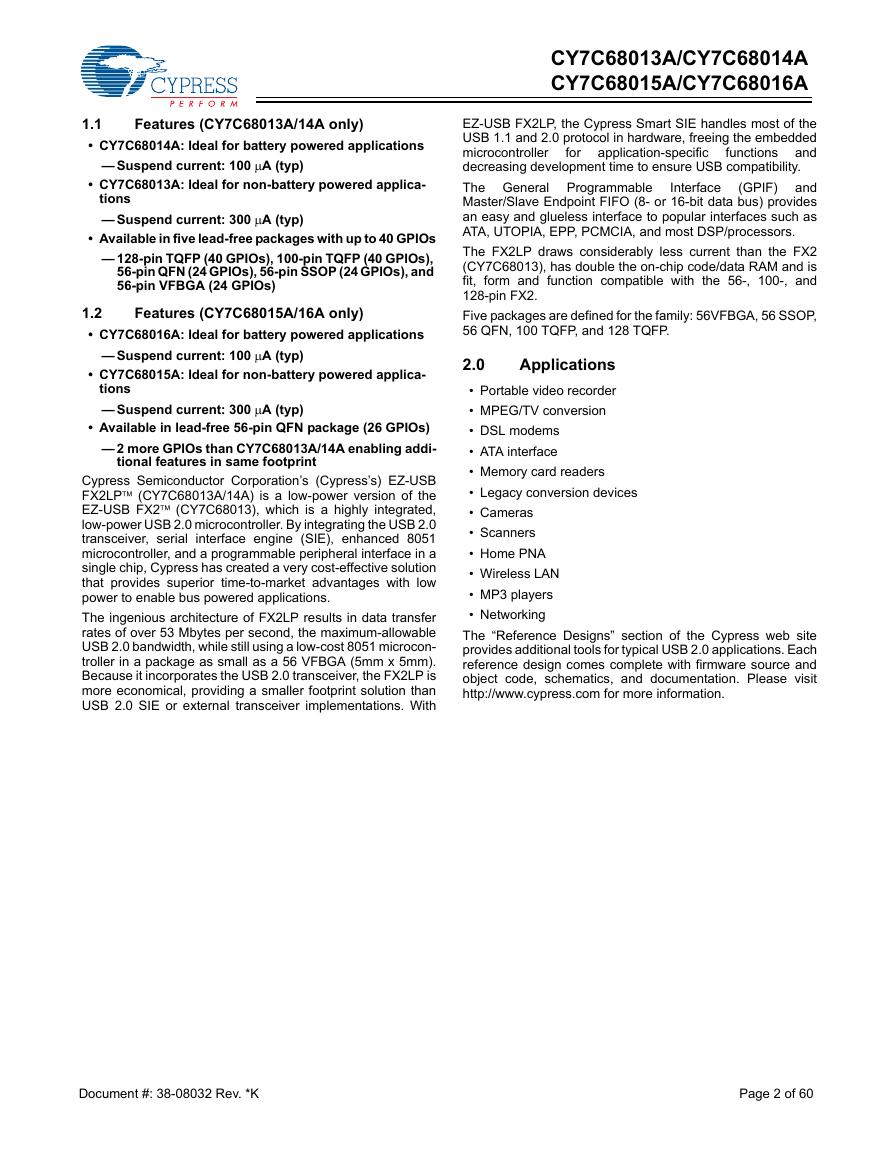
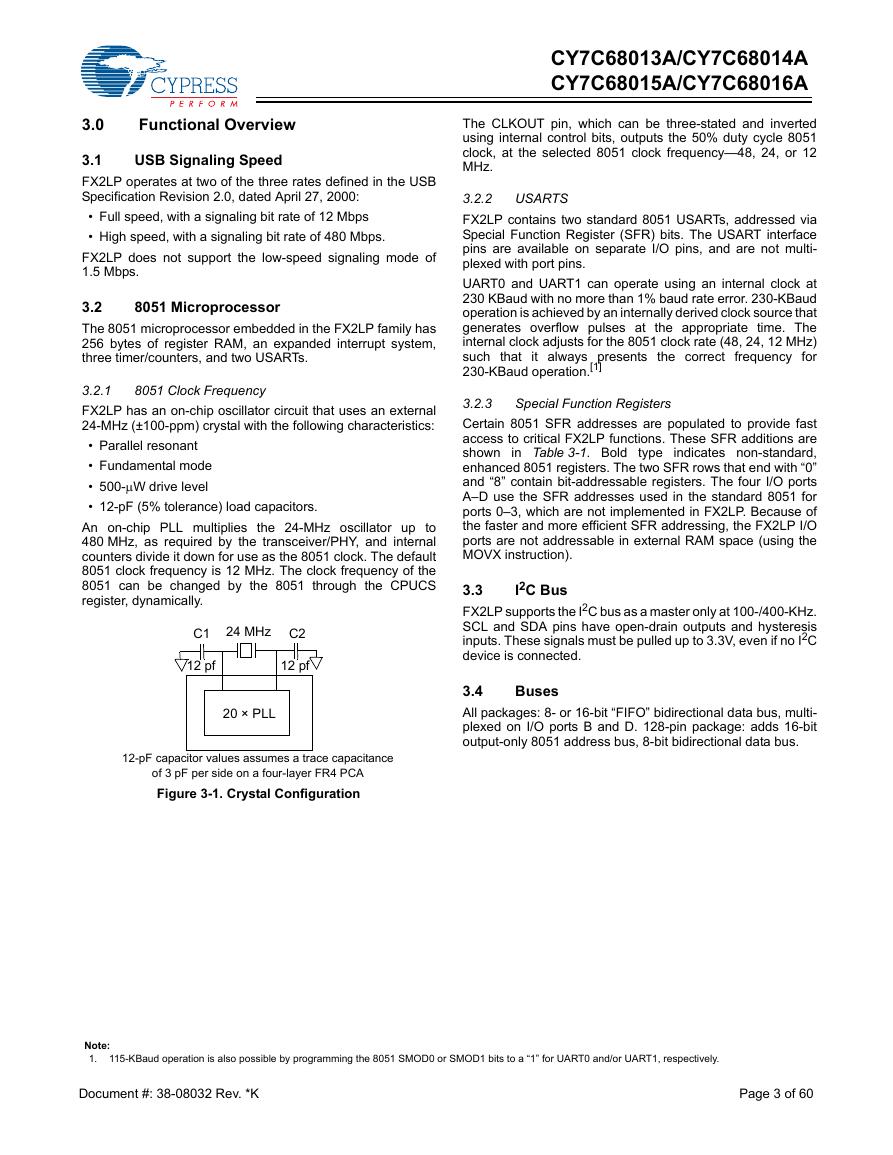
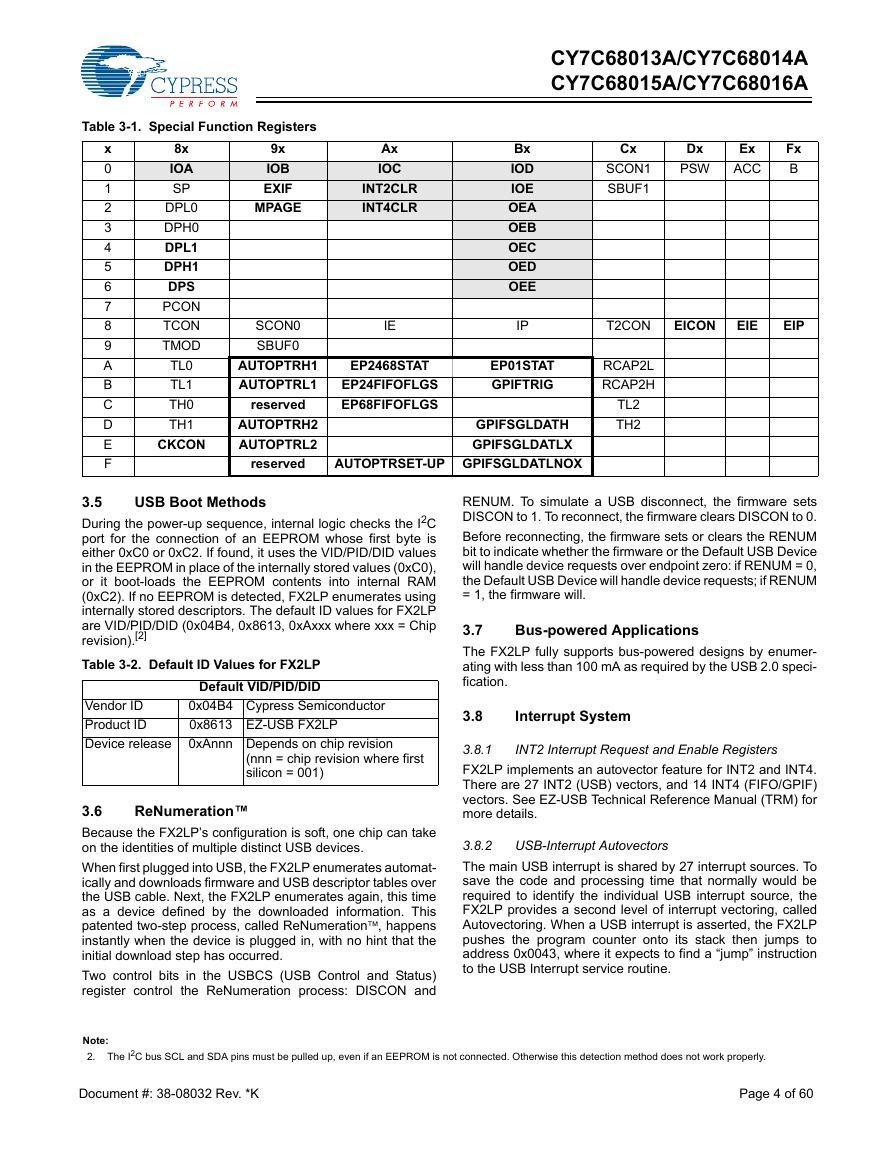


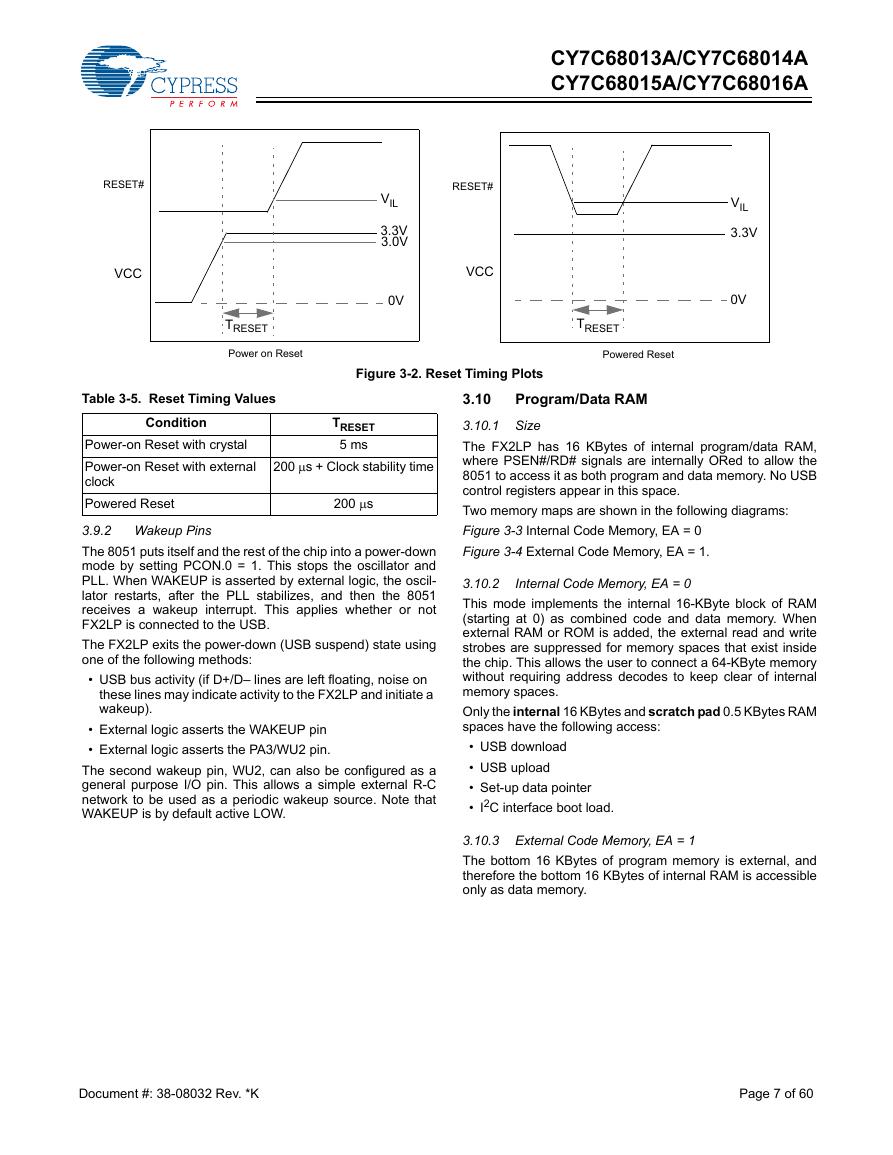









 V2版本原理图(Capacitive-Fingerprint-Reader-Schematic_V2).pdf
V2版本原理图(Capacitive-Fingerprint-Reader-Schematic_V2).pdf 摄像头工作原理.doc
摄像头工作原理.doc VL53L0X简要说明(En.FLVL53L00216).pdf
VL53L0X简要说明(En.FLVL53L00216).pdf 原理图(DVK720-Schematic).pdf
原理图(DVK720-Schematic).pdf 原理图(Pico-Clock-Green-Schdoc).pdf
原理图(Pico-Clock-Green-Schdoc).pdf 原理图(RS485-CAN-HAT-B-schematic).pdf
原理图(RS485-CAN-HAT-B-schematic).pdf File:SIM7500_SIM7600_SIM7800 Series_SSL_Application Note_V2.00.pdf
File:SIM7500_SIM7600_SIM7800 Series_SSL_Application Note_V2.00.pdf ADS1263(Ads1262).pdf
ADS1263(Ads1262).pdf 原理图(Open429Z-D-Schematic).pdf
原理图(Open429Z-D-Schematic).pdf 用户手册(Capacitive_Fingerprint_Reader_User_Manual_CN).pdf
用户手册(Capacitive_Fingerprint_Reader_User_Manual_CN).pdf TechnicalReference_Dem.pdf
TechnicalReference_Dem.pdf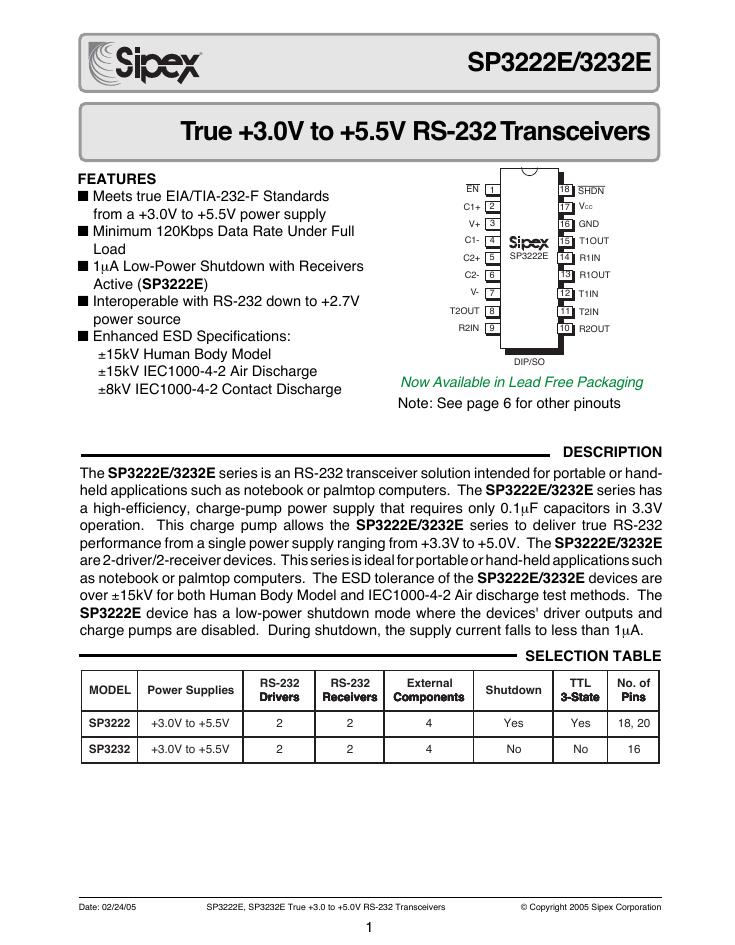 SP3232EEN 手册(SP3232EEN).pdf
SP3232EEN 手册(SP3232EEN).pdf